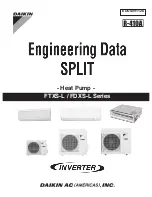
28
RT-SVX50C-EN
Troubleshooting
Standard Troubleshooting
Failures
Cooling Failure
1.
Cooling and heating set point (slide pot) on the
thermostat has failed.
2. CC1 or CC2 24 VAC control circuit has opened. Check
CC1 & CC2 coils, and any of the controls below that
apply to the unit (HPC1, HPC2, LPC1, LPC2, DLT1, DLT2,
Frostat™).
Simultaneous Heat and Cool Failure
•
Emergency Stop is activated.
Low Leak Economizer
(LLE) Troubleshooting
1.
The economizer controller provides alarm messages
that display on the 2-line LCD. If one or more alarms are
present and there has been no keypad activity for at
least 5 minutes, the Alarms menu displays and cycles
through the active alarms.
Note:
You can also navigate to the Alarms menu at any
time.
2. Once the alarm has been identified and the cause has
been removed (e.g. replaced faulty sensor), the alarm
can be cleared from the display.
Note:
If an alarm still exists after you clear it, it re-displays
within 5 seconds.
To Clear an Alarm
Once the alarm has been identified and the cause has been
removed (e.g. replaced faulty sensor), the alarm can be
cleared from the display.
1.
Navigate to the desired alarm.
2. Press .
3. “ERASE?” is displayed.
4. Press .
5. “ALARM ERASED” is displayed.
6. Press
(Menu Up) to complete the action and return
to the previous menu.
Note:
If an alarm still exists after you clear it, it re-displays
within 5 seconds.
Low Leak Economizer Fault Codes
Low Leak Economizer Alarms:
•
CO2 Sensor Error
•
SYS Alarm
•
Actuator Undervoltage
•
Actuator Overvoltage
•
Actuator Stalled
The FDD system shall detect the following faults:
•
Air temperature sensor failure/fault
•
Not economizing when it should
•
Economizing when it should not
•
Damper not modulating
•
Excess outdoor air
The JADE controller is a certified FDD product (HJW10) by
California Title 24, Part 6. The FDD system is required for
meeting California Energy Commission's Title 24
regulations.
Table 7, p. 29
shows the various tests that can
be performed (rows) and the five faults that are defined by
FDD (columns). The 'x' means that the test has to be
conducted to see if it is causing the fault to occur.
WARNING
Hazardous Service Procedures!
The maintenance and troubleshooting procedures
recommended in this section of the manual could result
in exposure to electrical, mechanical or other potential
safety hazards. Always refer to the safety warnings
provided throughout this manual concerning these
procedures. Unless specified otherwise, disconnect all
electrical power including remote disconnect and
discharge all energy storing devices such as capacitors
before servicing. Follow proper lockout/tagout
procedures to ensure the power can not be
inadvertently energized. When necessary to work with
live electrical components, have a qualified licensed
electrician or other individual who has been trained in
handling live electrical components perform these
tasks. Failure to follow all of the recommended safety
warnings provided, could result in death or serious
injury.





































